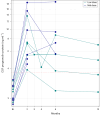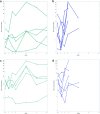Progranulin AAV gene therapy for frontotemporal dementia: translational studies and phase 1/2 trial interim results
- PMID: 38745011
- PMCID: PMC11108785
- DOI: 10.1038/s41591-024-02973-0
Progranulin AAV gene therapy for frontotemporal dementia: translational studies and phase 1/2 trial interim results
Abstract
GRN mutations cause progranulin haploinsufficiency, which eventually leads to frontotemporal dementia (FTD-GRN). PR006 is an investigational gene therapy delivering the granulin gene (GRN) using an adeno-associated virus serotype 9 (AAV9) vector. In non-clinical studies, PR006 transduced neurons derived from induced pluripotent stem cells of patients with FTD-GRN, resulted in progranulin expression and improvement of lipofuscin, lysosomal and neuroinflammation pathologies in Grn-knockout mice, and was well tolerated except for minimal, asymptomatic dorsal root ganglionopathy in non-human primates. We initiated a first-in-human phase 1/2 open-label trial. Here we report results of a pre-specified interim analysis triggered with the last treated patient of the low-dose cohort (n = 6) reaching the 12-month follow-up timepoint. We also include preliminary data from the mid-dose cohort (n = 7). Primary endpoints were safety, immunogenicity and change in progranulin levels in cerebrospinal fluid (CSF) and blood. Secondary endpoints were Clinical Dementia Rating (CDR) plus National Alzheimer's Disease Coordinating Center (NACC) Frontotemporal Lobar Degeneration (FTLD) rating scale and levels of neurofilament light chain (NfL). One-time administration of PR006 into the cisterna magna was generally safe and well tolerated. All patients developed treatment-emergent anti-AAV9 antibodies in the CSF, but none developed anti-progranulin antibodies. CSF pleocytosis was the most common PR006-related adverse event. Twelve serious adverse events occurred, mostly unrelated to PR006. Deep vein thrombosis developed in three patients. There was one death (unrelated) occurring 18 months after treatment. CSF progranulin increased after PR006 treatment in all patients; blood progranulin increased in most patients but only transiently. NfL levels transiently increased after PR006 treatment, likely reflecting dorsal root ganglia toxicity. Progression rates, based on the CDR scale, were within the broad ranges reported for patients with FTD. These data provide preliminary insights into the safety and bioactivity of PR006. Longer follow-up and additional studies are needed to confirm the safety and potential efficacy of PR006. ClinicalTrials.gov identifier: NCT04408625 .
© 2024. The Author(s).
Conflict of interest statement
J.S., O.U., L.D.H., L.C.W., D.A.H., A.T., S.B., P. Sheehan, A.B., S.R.B., B.M.S., S.K., C.W.D., E.D.L., E.M., J.V., I.M., P. Sondergaard, S.A.S., Y.M.K., A.A. and F.H. have been or currently are employees of Prevail Therapeutics, a wholly owned subsidiary of Eli Lilly and Company. R.V. serves as principal investigator in clinical trial agreements by the University of Leuven with Alector, AviadoBio, Biogen, Denali Therapeutics, Eli Lilly, Johnson & Johnson, NovoNordisk, Prevail, Roche and UCB, and he has consultancy agreements with ACImmune and Novartis. D.J.I. serves as principal investigator in clinical trial agreements with Prevail Therapeutics, Transposon, Passage Bio, Alector and Denali Therapeutics. D.S. is a sub-investigator of the Prevail study reported in this publication. I.L.B. is the national coordinator of the Prevail study in France and is an investigator in another study on genetic frontotemporal dementia sponsored by Alector (AL001). R.A. received speaker fees from Biogen and serves on scientific advisory boards for Eli Lilly, Biogen, Roche and Eisai. J.D.R. has provided consultancy and served on the medical advisory board for Prevail. He has also provided consultancy and served on medical advisory boards for Novartis, Wave Life Sciences, Alector, Aviado Bio, Arkuda and Denali Therapeutics. A.L.B. has served as a paid consultant to Applied Genetic Technologies Corporation, Alector, Alzprotect, Amylyx, Arkuda, Arrowhead, Arvinas, Aviado, Boehringer Ingelheim, Denali Therapeutics, Eli Lilly, GlaxoSmithKline, Humana, Life Edit, Merck, Modalis, Oligomerix, Oscotec, Roche, Transposon and Wave Life Sciences. His institution received research support from Biogen and Eisai for serving as a site investigator for clinical trials as well as from Regeneron.
Figures










References
Publication types
MeSH terms
Substances
Associated data
Grants and funding
LinkOut - more resources
Full Text Sources
Medical
Molecular Biology Databases
Miscellaneous

